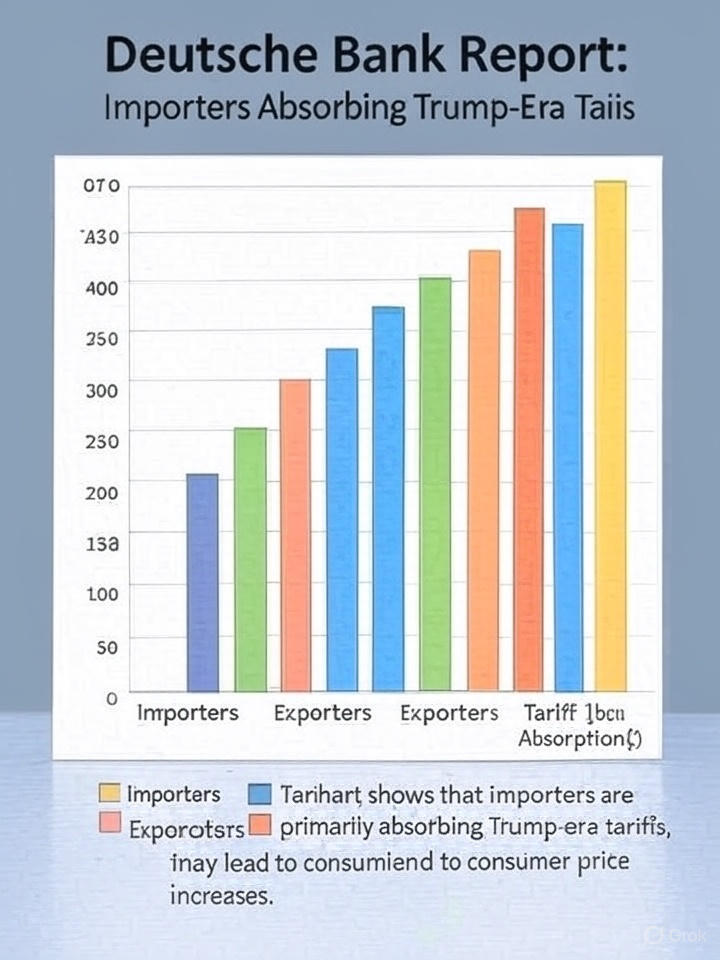Background
The Trump administration reintroduced a series of tariffs in early 2025, targeting a wide range of imported goods including steel, aluminum, auto parts, and electronics. These measures aimed to protect domestic industries but raised concerns about who ultimately bears the cost. The U.S. government has already collected over $100 billion in Trump tariff revenue so far this year. Analysts and policymakers have debated whether foreign exporters absorb the tariffs or if U.S. importers and, eventually, consumers shoulder the burden.
Deutsche Bank’s Analysis
In a Q2 2025 report, Deutsche Bank economists conducted a “top down macro” assessment of U.S. import prices. They reasoned: if foreign exporters were absorbing the tariffs, import prices should sharply decline. Instead, their findings revealed only modest price reductions chiefly from Canada and the U.K. while for major exporters like China, import prices dropped a mere 1%, despite a 30% tariff hike (Business Insider, Globedge).
George Saravelos, Deutsche Bank’s global head of FX research, noted:
“The top‑down macro evidence seems clear: Americans are mostly paying for the tariffs.” (Yahoo Finance)
This suggests that U.S. importers are absorbing the cost likely via reduced profit margins rather than passing it onto consumers. And because inflation so far remains relatively contained (June CPI rose just 0.3%), it confirms that firms have been shouldering the burden for now (Yahoo Finance).
Implications for Consumers and the Economy
- Upcoming Inflation Risk
Deutsche Bank warns that consumer prices could soon rise, as importers may no longer absorb the tariffs and begin passing costs onto customers (Business Insider). - Corporate Earnings Under Pressure
Companies like General Motors and Stellantis have already reported massive losses ($1.1 billion and $350 million, respectively), directly tied to tariff exposure (MarketWatch, AInvest). As margins shrink, profitability is under strain. - Weakened U.S. Dollar
Since foreign exporters are not feeling Trump Tariffs pain, they maintain pricing power potentially increasing U.S. import costs and putting downward pressure on the dollar (MarketWatch). - Strengthened Negotiating Leverage for Trade Partners
Exporters unaffected by tariffs have more leverage in potential negotiations ahead of the Aug 1 tariff deadlines (Business Insider).
Counterarguments: White House & Historical Context
- White House Position: The administration’s Council of Economic Advisers (CEA) claims import good prices have actually declined overall, aided by falling energy costs, and that tariffs haven’t spurred inflation (Business Insider).
- Historical Perspective: Earlier research such as the 2018 Journal of Economic Perspectives similarly found that importers and consumers, rather than exporters, typically bear most tariff costs (Financial Times). However, inflationary impacts vary depending on policy and market conditions.

Macro-Level Takeaways
| Factor | Short-Term Impact | Medium/Long-Term Outlook |
|---|---|---|
| Importers | Absorbing tariffs, profit margins squeezed | May shift costs to customers once margins cannot sustain losses |
| Consumers | Minimal impact so far | Likely to face higher prices soon |
| Exporters | Largely unaffected | Maintain strong pricing power in negotiations |
| Dollar | Slightly weaker | Pressure may increase if cost burden shifts to U.S. |
| Inflation | CPI +0.3% in June | Could increase sharply if tariffs are passed on |
Summary
- Deutsche Bank concludes that U.S. importers, not foreign exporters, are currently paying most of the new Trump tariff (New York Post, GuruFocus, MarketWatch, Business Insider, Wikipedia).
- Firms are managing costs through lower margins, which temporarily shields consumers.
- Consumer prices are expected to increase soon, as tariffs ripple through to retail pricing.
- Corporate earnings, especially in manufacturing and retail, are being hit diminishing profits.
- The U.S. dollar weakens, and trading partners gain negotiation leverage.
- The White House contests this, pointing to declining import prices overall but history and data suggest the tariff burden usually lands domestically.
Deutsche Bank’s analysis underscores a key economic lesson: what seems like protectionist gain for producers often ends up slicing into domestic business revenues and eventually consumer wallets.

